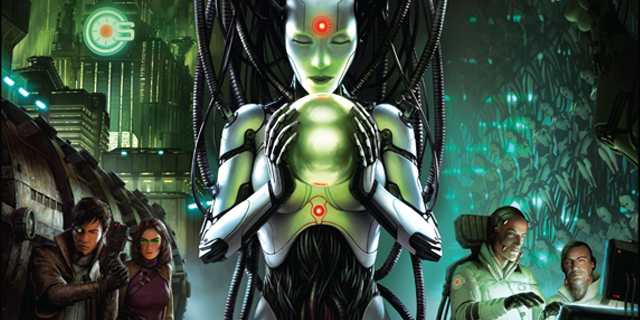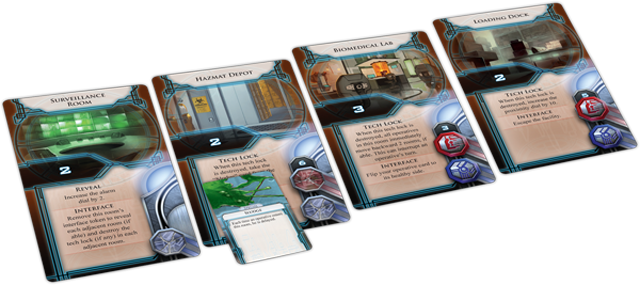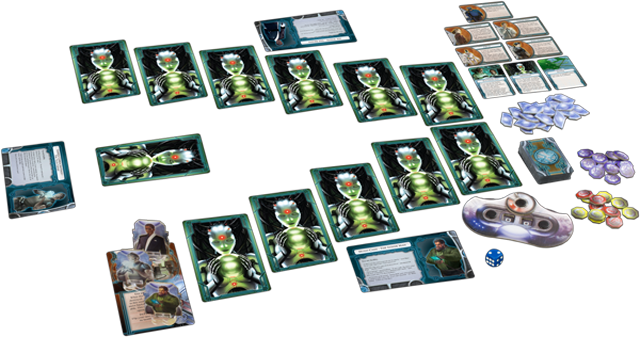
As much as I love the sci-fi noir game Android, it unfortunately requires a lot of effort to play due to space and time commitments, and as a result I don’t get to experience it as often as I would like. Fortunately, the people at Fantasy Flight Games seem to enjoy the universe they have created as well. They have already published two novels set in and around New Angeles, the Heinlein Moon Colony and the Beanstalk that connects them, with more on the way.
But while I enjoy a good book, I was even more excited to hear of two new games being set in the Android universe coming out this year. The first, Infiltration, was just released. (The second is going to seriously threaten Sentinels of the Multiverse when it comes time to rank my favorites for my year-end column, but that will have to wait a couple more months.)
Infiltration is a game by Donald X. Vaccarino (Kingdom Builder, Dominion) that simulates a team of specialist operatvies infiltrating CyberSolutions Inc., a New Angeles megacorp on the brink of a major AI breakthrough that will allow them to rival the Android-established Haas-Bioroid and Jinteki. Each member of the team, led by a man known only as “Mr. White,” has their own reasons for wanting to take CyberSolutions down a peg, but don’t look for any personal storylines in Infiltration‘s gameplay. This game is all about getting in, stealing as much data as possible (maybe obtaining a super-valuable prototype along the way), and getting out before the security mercs show up and nail everyone to the wall. Of course, that last part is easier said than done…

Each player begins with four action cards: Advance (move forward one room), Retreat (move backwards one room), Interface (use your current room’s special function), and Download (obtain data files [DF] from your current room); advanced players can use Extract instead of Download, which adds more strategic play. They also receive four item cards at random, or two at random and two specific to your character in another advanced variant. Most items are one-shot actions that interact with elements in a room, mess with other players, or any number of other effects.
During the Selection phase, each player chooses one of their cards and places it face-down on the table. They are revealed and executed in player order during the Resolution phase. Player order is important to consider when making your selection, as there are benefits for, say, the first player to resolve their Download card in a room each round, and some room interactions are one-time only which makes for “first come, first served” situations.
Each room is represented by an oversized card that contains various pieces of information about that room. Most rooms have a set of available DF tokens (valued from one to three) and an interface function (possibly one-time, as indicated by removing the room’s Interface token when executing), while many have effects when revealed and/or entered. Some rooms have tokens representing tech locks or lab workers that can be destroyed by item cards and unlock additional DF tokens to the room’s supply; tech locks often have some other effect as well, as indicated on the room card.
The facility consists of twelve rooms, comprised of two floors of six rooms each (out of a possible twelve per floor). The second-floor rooms tend to have bigger DF pools and better potential rewards, but represent higher risk as well. There is also one secret room (of three cards provided) that might be accessible during the course of play if the right first- and/or second-floor rooms are encountered. Only the very first room is revealed at the beginning of play, while the others will have to be discovered as players use Advance actions and other methods to delve deeper into the facility.

As mentioned, some rooms have effects on the game when revealed. Some rooms contain NPCs that will make the players’ lives miserable. They do what they do during the NPC phase, which follows the Resolution phase, and usually make their way backwards through the facility until they exit or are destroyed by a player’s item. Other reveal effects (and one NPC’s effect) will increase the Alarm Dial, which comes into play during the final phase of each round, the Security phase. Once the NPCs are done, the current first player rolls a six-sided die, adds that result to the current Alarm Dial value, and then increases the Proximity Meter by that much. The Proximity Meter starts at zero. When it hits 99 (whether in the Security phase or through some other effect) the game is over — and anyone who has not yet left the facility (by Retreating from the starting room or some other effect) is caught and scores nothing.
This is the other main component to Infiltration’s strategy: knowing when to press your luck and when to bail. The Proximity Meter can be unpredictable, and as the Alarm Dial climbs the pressure is only going to get worse. You have to keep in mind that it is going to take you N turns to escape, where N is how many rooms you have to pass through, one at a time, until you reach either the entrance or one of the two possible escape routes somewhere in the facility — if they’ve even been dealt into the game’s layout, that is.
You also have to consider what will happen should your operative become “delayed”. A delayed operative cannot play their Advance or Retreat actions on their next turn, further slowing down their progress in or out, and will no longer be delayed after their next turn. If an operative becomes wounded by an effect, then they become delayed whenever they resolve their Advance or Retreat actions, effectively halving their speed. If you get wounded with no way to heal (some room effects, one item), you really have some tough choices to make. Once an operative has escaped the facility they are eliminated from the game until it comes time to count up the value of their stolen DF tokens, but if only one operative escapes before the security mercs arrive then it doesn’t really matter how many zettabytes of data they have!

I really only have one issue with Infiltration: the non-room cards. Many FFG games use these tiny Euro-sized cards for whatever reason, and Infiltration is no exception. While this is tolerable due to use of icons in some cases, and justified by box size in others, the cards in Infiltration tend to have a lot of tiny, almost unreadable text and only one-third of the box is actually used for storage. This isn’t a deal-breaker or anything, but it is annoying given the box size they chose to use. I know FFG has smaller boxes available for their Silver Line, but I guess they wanted Infiltration to be more attention-grabbing but still carry a reasonable MSRP.
That MSRP is about $35, by the way, which even with the micro-cards is a great deal for a quick-playing game that supports from two to six players. Due to the amount of text, and perhaps more importantly its somewhat mature themes, Infiltration is not recommended for players under the age of fourteen. That is obviously going to vary depending on the maturity level of any tweens in your life, but I think it’s a fair estimate.



















